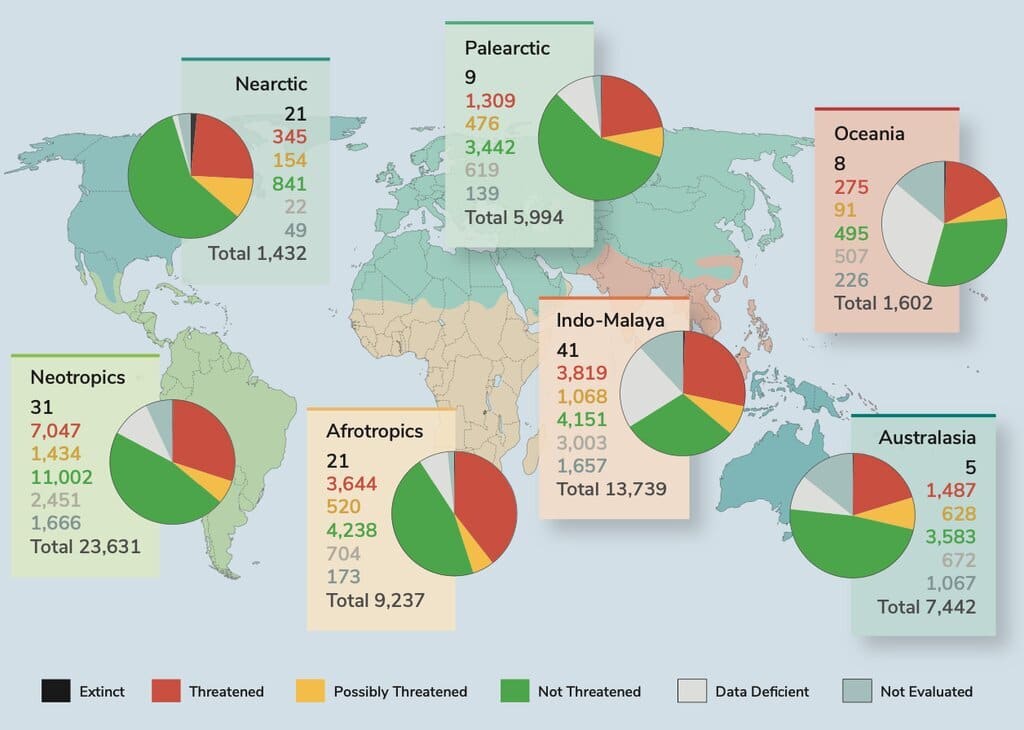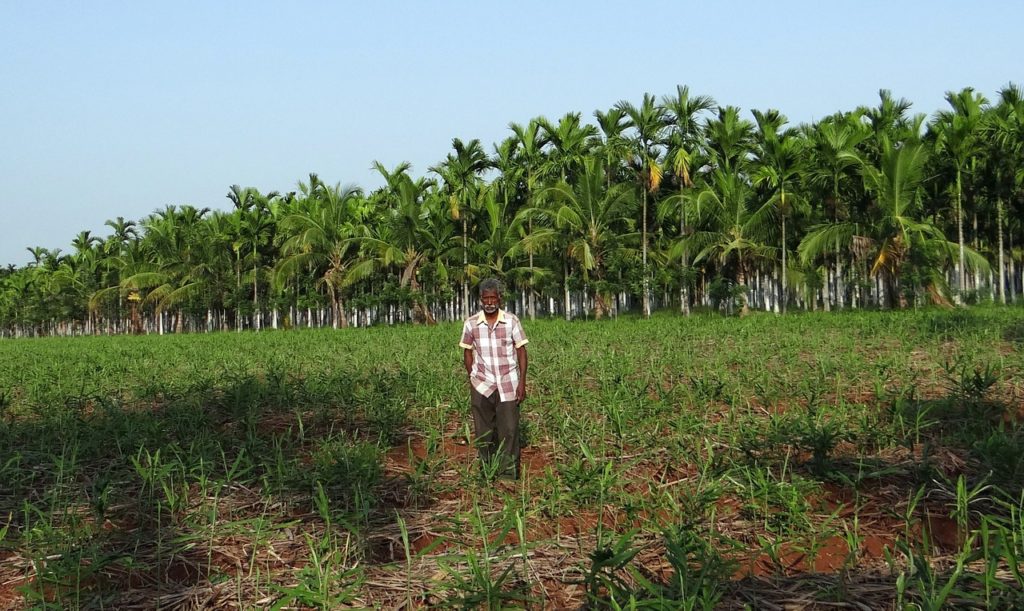The extinction rate of plants is accelerating at an unprecedented speed: the 2020 State of the World’s Plants and Fungi Report found that 39.4% of the world’s plants are now threatened with extinction, a huge jump from the estimated one in five plants predicted in the 2016 report. There are many endangered plant species that are found all across the world but particularly in biodiversity ‘hotspots’ in the tropics and the Mediterranean. Countries such as Australia, India, and Hawaii have some of the highest amounts of endangered plants. The worrisome trend, experts argue, is destined to continue in the upcoming years. Indeed, as a 2018 study by botanist Alan Gray found: “drivers of plant extinction may have an inertia that could last well into the future”. But what are these drivers, what are the main endangered species of plants, and what are the potential effects of plant loss?
—

Why Are Plants So Important?
Plants and fungi are the building blocks of life on planet Earth. They are used as medicines and treatments that save the lives of millions of people every year, they represent a source of food and energy, provide humanity with building materials and clean air, and they have the potential to solve urgent problems that threaten human life.
New data that emerged from the 2020 State of the World’s Plants and Fungi Report show that despite the existence of more than 7,000 edible and nutritious plants, 90% of humanity’s food energy intake derives from just 15 plants. Simultaneously, almost half of the world’s population relies on just three crops: rice, maize and wheat. As for their use in medicine, plants make up a huge portion of treatments, used to treat deadly illnesses such as cancer and heart diseases as well as several skin conditions. Approximately 4 billion people rely on herbal medicines as their primary source of healthcare. Out of the top 150 drugs prescribed in the United States, at least 118 are based on natural sources.
But plants are not only crucial for humans. Plant species such as seaweed, for example, are also vital for the conservation of shallow marine ecosystems. These algae break the flow of water and thus help to prevent coastal erosion. They also promote species diversity by providing habitat, nutrients, and energy for millions of animals.
Another example of vital plants is trees: they represent a precious resource that can help tackle pollution, a threat to human health, climate and ecosystems around the world. According to the 2021 State of the World’s Trees Report, a third of the world’s trees are currently at risk of extinction.

You might also like: 8 Stunning Endangered Species Facts to Know About
What Are the Drivers of Plant Extinction?
Deforestation, mass-agriculture, logging, and livestock farming are among the top threats to plant diversity. But climate change and extreme weather conditions are considered to be emerging dangers.
Overharvesting of some plant species to satisfy human needs has placed many medical and food species at risk of extinction. The main drive of overexploitation stems from the unprecedented global demand for naturally-driven medicines and edible plants. Some examples of endangered species of plants that are highly valued for the medicines they provide are Black Cohosh – a root used to support women’s health ailments and to ease arthritis and inflammatory conditions, American and Asian Ginseng – famous for its healing properties, and Wild Yam, used to reduce inflammation and support metabolism.
As mentioned before, around a dozen plants and just three crops are used to satisfy the food energy intake needs of more than 4 billion people. As experts argue, relying on a handful of crops to feed the global population accounts for the loss of 75% of global farmed plant diversity compared to pre-1900. Endangered edible plant species include coffee plants -– two-thirds of which are at risk of extinction – cocoa plants, and staple crops such as maize and potatoes. While excessive demand and overexploitation of these plants put them at risk, climate change also plays a large role in their disappearance. As temperatures rise and rainfall drops, pests and diseases are more likely to spread, while insects or mould destroy outdoor crops. The loss of crops further leaves us vulnerable to climate change, contributing to malnutrition by reducing nutrient availability and affecting global food security.
The same discourse goes for the aforementioned seaweed, an overexploited plant used for direct human consumption as well as implemented for the preparation of feeds, fertilisers, biofuels, cosmetics, and medicines. As Juliet Brodie, Professor at the London Natural History Museum, said: “As we continue to exploit our coastal ecosystems, seaweeds face a race against time for us to understand and protect them before it’s too late.”
What Risks Do Endangered Plant Species Pose?
Losing plant species creates a dangerous domino effect as it drives a loss of animal diversity, makes ecosystems even more vulnerable to climate change, extreme weather, and puts human health and the entire food chain at risk. Indeed, ecosystems are a complex network made up of animals, plants, and other organisms coexisting and working together. Losing part of these species can have monumental effects across the entire ecosystem. As experts put it: ‘extinction breeds extinction’. Thus, protecting plant species is thus crucial not only to protect the environment but also to ensure food security and human health.
What Can We Do to Protect Endangered Plants?
One of the most effective policies to date to protect plants and animal species threatened with extinction is the Endangered Species Act (ESA). The law, passed in the US in 1973, allows individuals and organisations to petition to have a species listed as endangered or threatened. After undergoing scientific review, classified endangered species are to be protected and to do so, long-term recovery plans for critical habitat areas are set up to prevent extinction. These plans cover a range of factors such as habitat, food availability, reproduction rate, and climate.
The law is still the country’s best – and only – option to protect endangered species. And while it has proven to be more than 99% successful at preventing extinction, given that at least 227 endangered species have been saved since the law was passed five decades ago, there are other ways to help conserve plants and protect those at risk of extinction that everyone can do. First and foremost, we can educate ourselves and the people around us about threatened species, researching what plants are at risk in the areas we live in and the potential consequences we would face if they were to disappear. Another important way is to preserve the environment around us, leaving it untouched and undisturbed. Avoiding toxic pesticides and herbicides in our yard is also crucial, as the chemicals contained in these products are extremely detrimental. As for edible plants such as coffee and cocoa, opting for Fair Trade brands, whose production is ethical and involves the least amount of environmental destruction, is always a good choice. Finally, people must commit to reducing their environmental footprint as much as possible, avoiding activities that can pollute the habitat around us, and being conscious that our actions can have detrimental effects.
You might also like: 10 of the World’s Most Endangered Animals in 2022


















